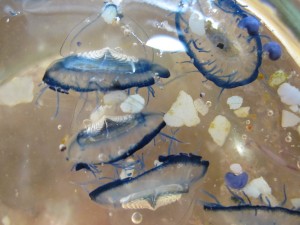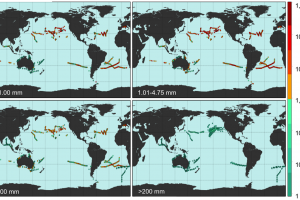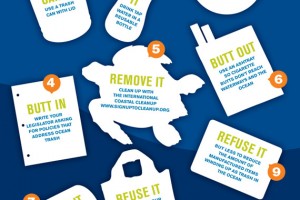When I first read about the Pacific Garbage Patch, my knee-jerk reaction was, “Why can’t we clean it up?” Several other have had the same reaction, such as Dutch engineering student Boyan Slat (featured in a 2012 TED talk) and a retired UC Davis professor who wrote to me.
Boyan Slat’s idea features a number of T-shaped collectors anchored to the sea floor that use the ocean’s natural waves and currents to concentrate plastic. Instead of nets, Slat proposes a barrier-like boom that allows currents to pass under while capturing buoyant plastic. He estimates that each of the five ocean gyres can be cleaned in five years.
Retired environmental chemist James A. Singmaster suggests, “Floating plastic in the Pacific Gyre could be scooped up and taken to, say Hawaii, where pyrolysis, the process to make charcoal, could be applied to it once dried, perhaps with a little pre-water washing to remove salt. Pyrolysis will convert about 50% of the carbon present to inert charcoal with the other 50% being expelled much like a light oil well fluid. That fluid can be burned for energy or refined like oil to get chemicals used to make drugs, detergents, glues, etc.”
Any effort to address the plastic problem is worthy of congratulations, but not all ideas are created equal. I asked the three scientists featured in Plastic, Ahoy! Investigating the Great Pacific Garbage Patch what they thought about these proposals. Miriam Goldstein and Chelsea Rochman referred me to a guide they co-wrote for Marine Affairs Research Education (MARE) for would-be plastic cleanup inventors. In part, their guide advises:
- The surface area of the Great Pacific Garbage Patch is approximately 20,000,000 square kilometers. Traversing the entire area would be a monumental undertaking. Addititionally, “in even the most densely polluted regions of the subtropical gyres, microplastics (particles smaller than 5 mm in size) are frequently present at concentrations of less than one piece per square meter, requiring extensive areal coverage to recover just one kilogram of plastic. Furthermore, average water depth of the open ocean is 4,000 meters (2.5 miles); therefore, any cleanup system relying upon moored structures must account for this extreme depth.”
- Winds, storms, waves and currents mix the plastic below the surface of the water–a few meters in calm conditions to 150 meters in extreme conditions. Surface collection systems must account for this subsurface mixing.
- One of the goals of capturing plastic should be preserving marine life around it. “Most zooplankton, for example, do not survive being caught in a standard net, never mind spun in a centrifuge where they lose critical appendages like their antennae and feeding apparatus. A system that relies on nets or centrifuges will require engineered solutions to avoid or minimize these effects.” Additionally, indirect environmental impacts, such as fuel from clean-up vessels or incinerators at sea, should be considered.
- Entangling sea life/sea birds in cleanup systems is not acceptable.
- Cleanup systems must withstand extreme weather conditions all too common in the open ocean.
Velella velella jellies and microplastic (Photo by Annie Crawley)
- How will ocean cleanup systems be maintained? How will companies promoting ocean cleanup systems address the organisms who “raft” on the mechanisms (much like they hitchhike on floating logs, feathers, or plastic).
- The recycling value of the plastic collected may be low, because the chemical components degrade in the ocean over time. Upcyclers are few and far between.
- “There are extensive laws and regulations governing the deployment of equipment at sea. For example, structures cannot be a hazard to navigation or a threat to protected species. In the U.S., multiple permits from state and/or federal agencies may be required for cleanup devices. The permitting process is lengthy, onerous, and expensive, and may require specialized legal consultation.”
Of course, the best way to clean up the ocean is prevention–keep plastic from reaching the marine habitat. Read 10 Ways to Reduce Ocean Plastic This Earth Day and Everyday.








Leave a Reply
Your email is safe with me.